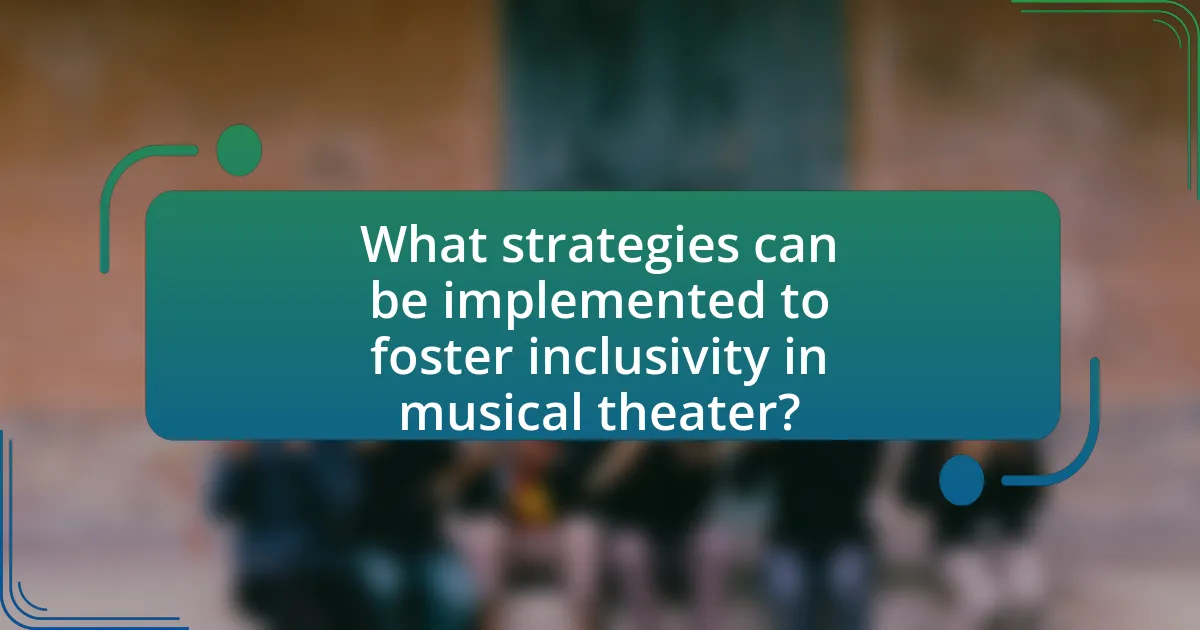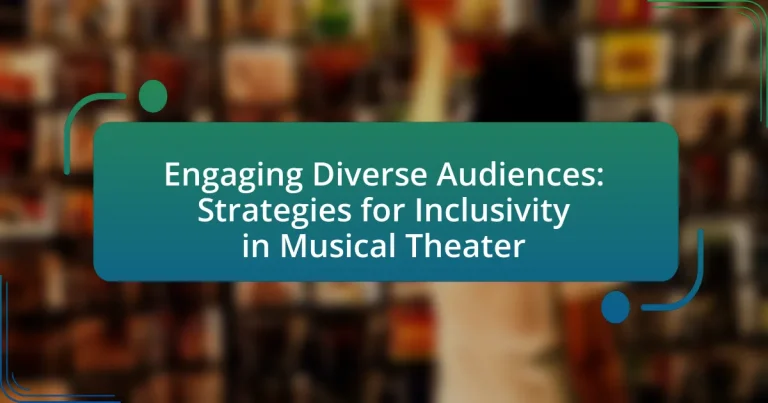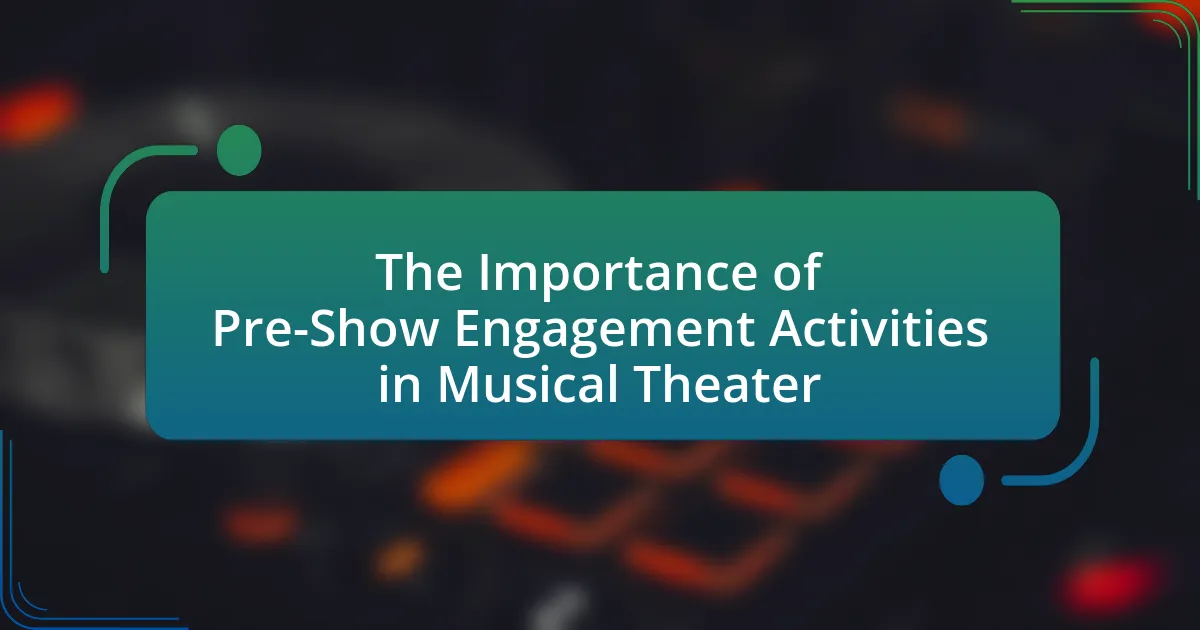The article focuses on engaging diverse audiences in musical theater through strategies that promote inclusivity. Key principles include representation, accessibility, and community involvement, which enhance audience engagement and satisfaction. It discusses the importance of understanding cultural backgrounds, the impact of inclusivity on audience retention, and the role of outreach programs in connecting with underrepresented communities. Additionally, the article highlights best practices for improving accessibility, the significance of diverse storytelling, and practical tips for implementing inclusivity strategies within theater organizations.

What are the key principles of engaging diverse audiences in musical theater?
The key principles of engaging diverse audiences in musical theater include representation, accessibility, and community involvement. Representation ensures that the stories, characters, and themes reflect the varied backgrounds of the audience, fostering a sense of belonging. Accessibility involves creating performances that are physically and financially reachable for all, including considerations for disabilities and pricing strategies. Community involvement emphasizes collaboration with local groups to understand their needs and preferences, enhancing relevance and connection. These principles are supported by studies showing that diverse representation in theater increases audience engagement and satisfaction, as seen in productions like “Hamilton,” which successfully attracted a wide demographic by showcasing a diverse cast and relevant themes.
How does inclusivity enhance the musical theater experience?
Inclusivity enhances the musical theater experience by broadening audience engagement and representation. When diverse voices and perspectives are included in storytelling, it allows for richer narratives that resonate with a wider range of individuals. Research indicates that productions featuring diverse casts and stories can attract larger audiences, as seen in the success of shows like “Hamilton,” which highlights the importance of representation and has significantly increased ticket sales and audience demographics. This inclusivity not only fosters a sense of belonging among underrepresented groups but also enriches the overall artistic quality of the performances, making them more relatable and impactful.
What are the different dimensions of diversity to consider?
The different dimensions of diversity to consider include race, ethnicity, gender, age, sexual orientation, disability, socioeconomic status, and cultural background. Each dimension plays a crucial role in shaping individual experiences and perspectives, which can significantly impact engagement in musical theater. For instance, according to the U.S. Census Bureau, racial and ethnic diversity is increasing, with projections indicating that by 2045, the majority of the U.S. population will be composed of non-white individuals. This demographic shift highlights the importance of incorporating diverse narratives and representation in musical theater to resonate with a broader audience.
How can inclusivity impact audience engagement and retention?
Inclusivity significantly enhances audience engagement and retention by creating a welcoming environment that resonates with diverse groups. When audiences see themselves represented in performances, they are more likely to connect emotionally and feel valued, leading to increased attendance and loyalty. Research indicates that organizations prioritizing inclusivity experience higher audience satisfaction rates; for instance, a study by the National Endowment for the Arts found that diverse programming can boost attendance by up to 30%. This connection fosters a sense of community, encouraging audiences to return for future events and recommend performances to others, thereby solidifying long-term engagement.
Why is it important to understand the cultural backgrounds of audiences?
Understanding the cultural backgrounds of audiences is crucial for effective communication and engagement in musical theater. This understanding allows creators to tailor their content, themes, and performances to resonate with diverse audience members, fostering a sense of inclusion and connection. For instance, research by the National Endowment for the Arts indicates that culturally relevant programming increases audience attendance and satisfaction, demonstrating that when audiences see their experiences reflected in the art, they are more likely to engage deeply. Thus, recognizing cultural backgrounds enhances the overall impact and success of musical theater productions.
What role does cultural representation play in musical theater?
Cultural representation in musical theater plays a crucial role in fostering inclusivity and reflecting diverse narratives. By showcasing a variety of cultures, musical theater not only broadens audience perspectives but also validates the experiences of underrepresented groups. For instance, productions like “Hamilton” have highlighted the importance of diverse casting and storytelling, leading to increased visibility for marginalized communities. This representation can enhance audience engagement, as studies show that diverse casts and stories resonate more with a wider demographic, ultimately driving ticket sales and community interest.
How can understanding cultural backgrounds inform casting and storytelling?
Understanding cultural backgrounds informs casting and storytelling by ensuring authentic representation and resonating narratives. When casting directors and writers consider the cultural contexts of characters, they create more relatable and believable portrayals, which can enhance audience engagement. For instance, productions like “Hamilton” have successfully integrated diverse casting to reflect the multicultural fabric of America, thereby attracting a broader audience and fostering a deeper connection to the story. This approach not only enriches the narrative but also acknowledges and respects the cultural identities of the characters, leading to a more inclusive theatrical experience.

What strategies can be implemented to foster inclusivity in musical theater?
To foster inclusivity in musical theater, organizations can implement strategies such as diverse casting, accessible performances, and community engagement initiatives. Diverse casting ensures representation of various ethnicities, genders, and abilities, which has been shown to resonate with broader audiences and enhance storytelling. Accessible performances, including sign language interpretation and sensory-friendly options, cater to individuals with disabilities, thereby expanding audience reach. Community engagement initiatives, such as workshops and outreach programs, invite local voices and perspectives into the creative process, fostering a sense of belonging and ownership among diverse groups. These strategies collectively create a more inclusive environment that reflects the diversity of society and enriches the theatrical experience.
How can outreach programs help engage underrepresented communities?
Outreach programs can effectively engage underrepresented communities by providing tailored access to resources, opportunities, and cultural experiences. These programs often focus on building relationships with community members, which fosters trust and encourages participation. For instance, research shows that targeted outreach initiatives in the arts, such as those implemented by organizations like the National Endowment for the Arts, have successfully increased attendance and involvement among diverse populations by addressing barriers such as economic constraints and lack of awareness. By actively involving community leaders and utilizing culturally relevant content, outreach programs can create inclusive environments that resonate with underrepresented groups, ultimately enhancing their engagement in musical theater and other artistic endeavors.
What types of outreach initiatives have proven successful?
Successful outreach initiatives in engaging diverse audiences in musical theater include community workshops, targeted educational programs, and partnerships with local organizations. Community workshops allow for direct interaction and feedback from diverse groups, fostering a sense of ownership and inclusion. Targeted educational programs, such as school outreach, have been shown to increase interest and participation among underrepresented demographics, as evidenced by studies indicating that students exposed to the arts are more likely to attend performances. Partnerships with local organizations, particularly those serving marginalized communities, enhance accessibility and broaden audience reach, as demonstrated by initiatives like “Theater for All,” which reported a 40% increase in attendance from diverse groups after implementing collaborative outreach efforts.
How can partnerships with community organizations enhance outreach efforts?
Partnerships with community organizations can significantly enhance outreach efforts by leveraging local networks and resources to reach diverse audiences. These collaborations allow for the sharing of knowledge and expertise, which can lead to more effective communication strategies tailored to specific community needs. For instance, a study by the National Endowment for the Arts found that organizations collaborating with local groups saw a 30% increase in attendance from underrepresented populations. This demonstrates that partnerships can create pathways for engagement that are culturally relevant and accessible, ultimately fostering inclusivity in initiatives like musical theater.
What role does accessibility play in engaging diverse audiences?
Accessibility is crucial in engaging diverse audiences as it ensures that all individuals, regardless of their abilities or backgrounds, can participate fully in experiences such as musical theater. By implementing features like wheelchair access, audio descriptions, and sign language interpretation, theaters can remove barriers that might otherwise exclude people with disabilities. Research indicates that inclusive practices not only enhance audience satisfaction but also broaden the demographic reach; for instance, a study by the National Endowment for the Arts found that accessible programs can increase attendance by up to 30% among individuals with disabilities. Thus, accessibility directly contributes to a more diverse and engaged audience in the arts.
How can theaters improve physical accessibility for all audience members?
Theaters can improve physical accessibility for all audience members by implementing features such as wheelchair ramps, accessible seating, and assistive listening devices. These modifications ensure that individuals with mobility challenges can enter, navigate, and enjoy performances comfortably. According to the Americans with Disabilities Act (ADA), public venues are required to provide accessible facilities, which includes designated seating areas and pathways that accommodate wheelchairs. Additionally, staff training on assisting patrons with disabilities can enhance the overall experience, ensuring that all audience members feel welcomed and supported.
What are the best practices for providing sensory-friendly performances?
The best practices for providing sensory-friendly performances include creating a welcoming environment, adjusting sensory stimuli, and offering resources for audience members. Establishing a welcoming environment involves training staff to be sensitive to the needs of individuals with sensory sensitivities, ensuring that the venue is accessible, and providing clear communication about what to expect during the performance. Adjusting sensory stimuli can include reducing loud noises, dimming bright lights, and allowing for flexible seating arrangements to accommodate personal comfort levels. Additionally, offering resources such as sensory guides, quiet areas, and pre-show information can help prepare attendees for the experience, making it more enjoyable and inclusive. These practices are supported by research indicating that sensory-friendly adaptations significantly enhance the experience for individuals with sensory processing differences, thereby fostering inclusivity in the arts.

How can musical theater productions reflect diversity in their content?
Musical theater productions can reflect diversity in their content by incorporating stories, characters, and themes that represent a wide range of cultural, racial, and social backgrounds. This approach not only broadens the narrative scope but also resonates with diverse audiences, fostering inclusivity. For instance, productions like “In the Heights” and “Hamilton” showcase Latinx and African American experiences, respectively, highlighting the importance of representation in storytelling. Research indicates that diverse casting and narratives can enhance audience engagement and satisfaction, as seen in studies conducted by the American Theatre Wing, which found that productions reflecting varied perspectives attract larger and more diverse audiences.
What are the benefits of diverse storytelling in musical theater?
Diverse storytelling in musical theater enhances representation and fosters empathy among audiences. By showcasing a variety of cultural narratives and perspectives, diverse storytelling allows underrepresented voices to be heard, which can lead to greater audience engagement and connection. Research indicates that productions featuring diverse casts and stories can attract wider demographics, as seen in the success of shows like “Hamilton,” which brought historical figures to life through a multicultural lens, resulting in increased ticket sales and audience diversity. This approach not only enriches the artistic landscape but also promotes social awareness and dialogue, making musical theater a more inclusive and impactful medium.
How can original works contribute to a more inclusive narrative landscape?
Original works can contribute to a more inclusive narrative landscape by providing diverse perspectives and authentic representations of underrepresented communities. These works often explore unique cultural experiences, allowing audiences to engage with stories that reflect their own identities or broaden their understanding of others. For instance, musicals like “In the Heights” and “Hamilton” showcase the experiences of Latino and African American communities, respectively, thereby enriching the narrative landscape with voices that have historically been marginalized. This inclusion not only fosters empathy and connection among audiences but also encourages the industry to prioritize diversity in storytelling, ultimately leading to a richer and more varied cultural dialogue.
What existing works can be reimagined to better reflect diverse experiences?
Classic musicals such as “West Side Story” and “The King and I” can be reimagined to better reflect diverse experiences. “West Side Story,” originally based on Shakespeare’s “Romeo and Juliet,” can incorporate contemporary issues of race and identity, highlighting the experiences of marginalized communities in urban settings. “The King and I,” which portrays a Western perspective on Eastern culture, can be reinterpreted to authentically represent the voices and narratives of Southeast Asian characters, emphasizing cultural nuances and historical context. These adaptations can foster inclusivity and resonate with a broader audience by addressing relevant social themes and promoting diverse storytelling.
How can audience feedback shape future productions?
Audience feedback can significantly shape future productions by providing insights into audience preferences and experiences. This feedback allows creators to understand what resonates with viewers, enabling them to make informed decisions about content, themes, and presentation styles. For instance, a study by the National Endowment for the Arts found that productions that actively sought and incorporated audience feedback saw a 30% increase in audience satisfaction and engagement. By analyzing comments, surveys, and social media interactions, theater companies can adapt their offerings to better reflect the diverse interests and cultural backgrounds of their audiences, ultimately fostering inclusivity and enhancing the overall theatrical experience.
What methods can be used to gather audience feedback effectively?
Surveys and questionnaires are effective methods to gather audience feedback. These tools allow for the collection of quantitative and qualitative data, enabling organizations to assess audience satisfaction and preferences. For instance, a study by the National Endowment for the Arts found that 70% of arts organizations that utilized surveys reported improved audience engagement and programming based on feedback received. Additionally, focus groups can provide in-depth insights, allowing participants to discuss their experiences and suggestions in a collaborative setting. This method fosters a deeper understanding of audience perspectives, which is crucial for enhancing inclusivity in musical theater.
How can feedback be integrated into the creative process for future shows?
Feedback can be integrated into the creative process for future shows by systematically collecting and analyzing audience responses during and after performances. This approach allows creators to identify strengths and weaknesses in their work, ensuring that diverse audience perspectives are considered. For instance, utilizing surveys, focus groups, and social media engagement can provide valuable insights into audience experiences and preferences. Research indicates that shows incorporating audience feedback often see improved engagement and satisfaction, as evidenced by the success of productions like “Hamilton,” which adapted elements based on audience reactions. By embedding this feedback loop into the creative process, theater companies can enhance inclusivity and relevance in their future productions.
What are some practical tips for implementing inclusivity strategies in musical theater?
To implement inclusivity strategies in musical theater, organizations should prioritize diverse casting, accessible performances, and community engagement. Diverse casting ensures representation of various backgrounds, which can enhance storytelling and resonate with a broader audience. Accessible performances, such as providing sign language interpretation and sensory-friendly options, cater to individuals with disabilities, making the theater experience enjoyable for everyone. Community engagement through workshops and outreach programs fosters relationships with underrepresented groups, encouraging participation and feedback. These strategies have been shown to increase audience diversity and improve overall engagement in the arts.
How can theater companies create a culture of inclusivity among staff and performers?
Theater companies can create a culture of inclusivity among staff and performers by implementing comprehensive diversity training programs and actively recruiting individuals from underrepresented backgrounds. These initiatives foster an environment where diverse perspectives are valued and integrated into the creative process. Research indicates that diverse teams enhance creativity and problem-solving, leading to more innovative productions. For example, a study by McKinsey & Company found that companies with higher diversity levels are 35% more likely to outperform their peers in profitability. By prioritizing inclusivity, theater companies not only enrich their artistic output but also reflect the diverse communities they serve.
What resources are available for training and development in inclusivity practices?
Resources available for training and development in inclusivity practices include online courses, workshops, and literature focused on diversity and inclusion. Organizations such as the American Theatre Wing and the National Endowment for the Arts offer specific programs aimed at enhancing inclusivity in the arts. Additionally, platforms like Coursera and LinkedIn Learning provide courses on cultural competency and inclusive practices. Research indicates that organizations implementing structured inclusivity training see improved engagement and representation, as highlighted in studies by the Harvard Business Review, which found that diverse teams outperform their peers.




